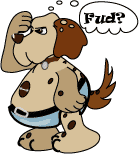

Canine hip dysplasia(TPO)
by Dr. N.J.Hayes
What is Canine hip dysplasia?
Canine hip dysplasia is a heritable
More commonly seen in large dogs, such as Labrador retrievers, golden retrievers, Rottweilers, Newfoundlands and other large breeds; this disease can be crippling. To understand canine hip dysplasia (CHD), one must first understand a little bit about the pelvis of the dog.
The pelvis is actually made up of three parts which fuse together in the puppy. These parts are the ilium, the ischium, and the pubis. (See drawing) Located on each side of the pelvis are the hip joints. The socket is called the acetabulum. The ball (head of the femur) fits into the socket. This is the hip joint.
How is the dog with hip dysplasia different?
 In a normal hip joint,
In a normal hip joint,  the ball or head of the femur fits deeply into the acetabulum.The photo to the left is an x-ray of the normal hip joint. Note how well the hip fits into the sockets. By definition, hip dysplasia is an abnormality of this joint. The ball of the femur is loose in the case of hip dysplasia. Many times the acetabulum is shallow.
the ball or head of the femur fits deeply into the acetabulum.The photo to the left is an x-ray of the normal hip joint. Note how well the hip fits into the sockets. By definition, hip dysplasia is an abnormality of this joint. The ball of the femur is loose in the case of hip dysplasia. Many times the acetabulum is shallow.
As hip dysplasia can be any degree of laxity, we grade it as mild to severe on a scale of one to four. Look at the following x-rays. They demonstrate each level of hip dysplasia. For larger views, click on each image.
 Early Grade Three Dysplasia
Early Grade Three Dysplasia  Arthritis with Grade three Dysplasia
Arthritis with Grade three Dysplasia
 Grade four Dysplasia"
Grade four Dysplasia"
 Arthritis with Grade four Dysplasia
Arthritis with Grade four Dysplasia
With time, all dysplastic hips will develop arthritis. Arthritis is the roughening of the joints. It causes stiffness and pain.
- Weakness and pain in the hindlegs and loss of muscle mass are the usual clinical signs.
- On physical exam, your veterinarian will find:
- joint laxity, characteristic of early disease; may not be seen in chronic cases owing to periarticular fibrosis (scaring of the joint)
- Crepitus - (grating in the joint)
- Decreased range of motion in the hip joints
- Atrophy of thigh muscles
How is it diagnosed?
Hip dysplasia must be diagnosed with x-rays otherwise called radiographs. Just examining the patient does not tell us if hip dysplasia exists. It is possible for dogs with severe subluxation such as the grades three or four to walk normally. Similarly, dogs with grade one hip dysplasia may be profoundly lame. For this reason, if we suspect hip dysplasia, x-rays under anesthesia will be recommended.
Is there any treatment for this?
There is treatment for dogs with hip dysplasia. Because early diagnosis can expand the treatment options, we recommend screening x-rays taken at the time your dog is spayed or neutered. X-rays will also be recommended if lameness is noted. In addition to medical management, there are surgical options. Medications such as pain relievers and chondroprotective drugs such as Glycoflex ®, can be helpful. Surgery may be needed to relieve your dog's pain. Fortunately there are some options available.
Surgical options include the TPO (triple pelvic osteotomy), the FHO ( femoral head ostectomy), and total hip replacement. (If you would like to view the surgical slides, please select the link at the top of the page.) The best choice of surgery will depend on your dog!dog's activity level, future function (such as hunting, agility, etc.), age, and the degree of hip dysplasia present.
The TPO is best for young dogs. The acetabulum or hip joint needs to be deep and without arthritis for the dog to be eligible. This procedure rebuilds the pelvis to create normal hip joint. For further information, see our handout entitled TPO which includes a link to the actual surgery photos of the procedure.
The FHO or femoral head ostectomy, can be done at any age or severity, though it is better suited to lighter weight dogs. It can be done in very large dogs, but the result is a looser gait than in smaller dogs. The FHO is a surgery the removes the ball of the femoral head. A muscular joint is all that's left. This surgery relieves pain and still allows moderate activity for the dog. It does not allow for extreme activity such as hunting or jumping in excess.
Total hip replacement is the replacement of the ball and joint of the pelvis. This surgery is best for large dogs that are no longer candidates for TPO. Due to the risk and complications, the surgery is best done at a university. Not all dogs are good candidates for the surgery.
What can I do to help my dog?
ACTIVITY - As tolerated:
- Swimming: recommended to maintain joint mobility while minimizing weight-bearing activities
- Diet: Weight control is very important; decrease the load applied to the painful joint; minimize weight gain associated with reduced exercise
- medical therapy is symptomatic only, because the joint instability is not corrected
Because each patient is different, which medication and or surgery protocol is best for your pet will be decided individually with the help of your veterinarian. We will be happy to explain all of your options for your pet. If you have any questions, please call: 309-685-4707